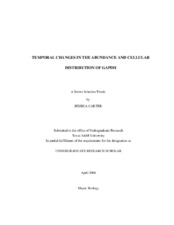Temporal Changed in the Abundance and Cellular Distribution of GAPDH
Abstract
Glyceraldehyde 3-phosphate dehydrogenase (GAPDH) is a metabolic enzyme originally thought to be only involved in glycolysis. New studies have shown that this protein contains novel functions not previously anticipated. Furthermore, separate circadian oscillations in glycolytic processes and “clock” genes exist. It is hypothesized that GAPDH is a potential link between the glycolytic and clock gene pathways. The changes in the amount and location of GAPDH in chicken retinas, pineal glands, and brain tissues at four time points throughout the day while in constant darkness (DD) were examined. GAPDH was localized using standard immunohistochemical techniques. In the retinal tissue, GAPDH was found in a high abundance in the ganglion cells, outer plexiform layer, outer nuclear layer, inner nuclear and plexiform layer, and the photoreceptor cell layer of the retina. Additionally, a circadian rhythm in GAPDH abundance was observed in the outer plexiform layer, outer nuclear layer, inner nuclear and plexiform layer, and the photoreceptor cell layer, which all had a rhythmic expression and gradual decrease at CT12. The pineal gland and parasympathetic terminals also displayed rhythmic expression. The parasympathetic terminal showed high abundance at CT0 and CT6, with a sharp drop at CT12. The pineal gland contained a similar temporal distribution, but with a gradual decrease to CT12. Data is still being collected on the brain sections. The results indicate that the relative abundance of the “glycolytic” protein, GAPDH, is under the control of an endogenous circadian clock.
Citation
Carter, Jessica (2006). Temporal Changed in the Abundance and Cellular Distribution of GAPDH. Available electronically from https : / /hdl .handle .net /1969 .1 /3651.


